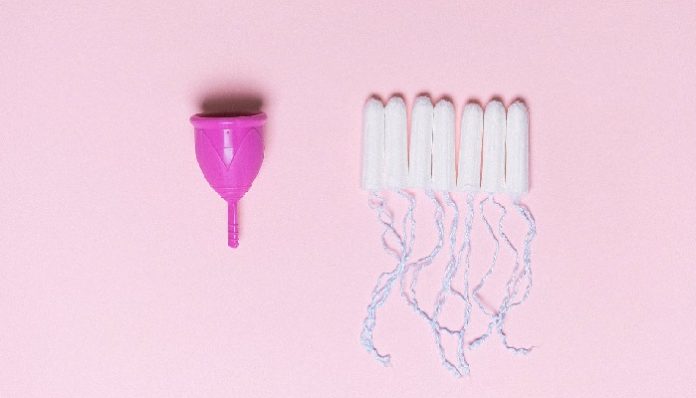
The days of the pad versus the tampon debate are long behind us. Period innovation has come up with some great new products, from a device that promises to magically dissolve cramps to menstrual cups. All this ingenuity brings us to a new argument: tampon or menstrual cup? The most popular type of menstrual cup is the DivaCup, although there are slight variations like Moon Cups or Soft Cup. All menstrual cups work basically the same way. You insert it similarly to a tampon and twist it 360 degrees to seal the edges. It collects any blood and allows you to go about the rest of your day in peace. As for the naysayers, let’s assess the pros and cons of each. How does a DivaCup really stack up against a tampon?
Ease of Use
The DivaCup can be tricky to figure out the first few times it’s used. Without getting too graphic, there’s quite a bit of fiddling and twisting at first. After a few uses though, you get to know how it fits in your body and insertion becomes much easier.
Tampons are also a bit finicky at first, but easier to learn then the DivaCup.
Winner: Tampons; they’re much simpler.
Leakage
A Diva is leaky if it’s not sealed correctly, and sealing can take some practice. It’s good to have a pantyliner on you just in case, but once you get good at sealing the cup it’s easier to go bare. When you know you’re sealed, you know you’re leak free for about 12 hours.
A tampon will prevent leaks immediately, but the length of time that you’re leak free can vary. Backup is usually needed with tampons, especially if you don’t want to be running to the bathroom to check for leaks every hour.
Winner: DivaCup, you’re guaranteed to be leak free for hours after you master the sealing technique.
Comfort
DivaCups can make cramps worse, unfortunately. They’re a little more intrusive, which usually doesn’t really effect your body unless your uterus is already agitated. However, if you’re not prone to cramps, the DivaCup is ideal. Most of the time, you can’t feel it and the long wear time makes it easy to forget that you’re even on your period.
Tampons can also make cramping worse, but they’re not as bad as a menstrual cup. The string can be irritating, but overall the experience is fairly comfortable.
Winner: Tampons. Cramping is bad enough, and large silicone cups just make it unbearable.
Length of Wear
The best part of the DivaCup is the 12 hour wear, no matter how heavy your flow. Thanks to silicone, the risk for bacterial infection is a lot lower too. The few minutes you spend rinsing out the cup is the only time during the day that you have to think about your period. It’s a beautiful thing.
Tampon wear time can vary, depending on how heavy your flow is. The 7 hour maximum is recommended to avoid scary issues like Toxic Shock Syndrome, as bacteria can start to grow in porous cotton if you leave it in your body for too long.
Winner: Diva. Who doesn’t want to temporarily forget about their period?
Cleaning
DivaCups are a bit messy to deal with. It collects blood during wear, so it has to be emptied and rinsed out every twelve hours. It should also be washed with unscented soap once a day, with a deep clean once your period is over. After a year, it’s probably time to get a new one though.
Tampons are super simple; just remove and dispose. Nothing to clean here!
Winner: Tampon. No muss, no fuss.
Environmental Impact
The crowning achievement of the DivaCup is its sustainability. It’s reusable for up to a year and the silicone is better for the environment than plastic, not to mention non-toxic. It’s not recyclable though, and DivaCup recommends that you cup it up into small pieces to throw it out, so it doesn’t trap animals.
Tampons are technically biodegradable, but the plastic applicators and casings aren’t. That doesn’t even start to cover the issues with cotton refinement and bleaching (which also isn’t great to be inserting into your body).
Winner: Diva Cup, much less waste for both the garbage and your plumbing.
Cost
Diva’s can run around $35 a pop. It’s not cheap, but when compared to it’s lifespan, $35 a year on period supplies starts to sound a bit better.
Although a box of tampons will only cost you about seven dollars, in order to compare you have to look into the longevity of a DivaCup. If the average woman goes through 20 tampons per cycle, that’s 240 tampons a year. With tampons costing 20 cents each (according to Walmart), that’s $45 dollars a year.
Winner: Not a huge difference, but the DivaCup comes out on top with savings of $10 a year.
Ultimately, each woman’s choice of her own period gear is her own. Although there are great aspects to both the DivaCup and tampons,everybody needs to make the choice depending on what is most important to them. Whether you’re concerned about cost, environmental impact, or minimizing leaks, there’s a solution for you. Whether you choose pads, tampons, or menstrual cups know that you’re a warrior for getting through menstruation; it’s not an easy feat.
Featured image via Anna Shvets on Pexels


















